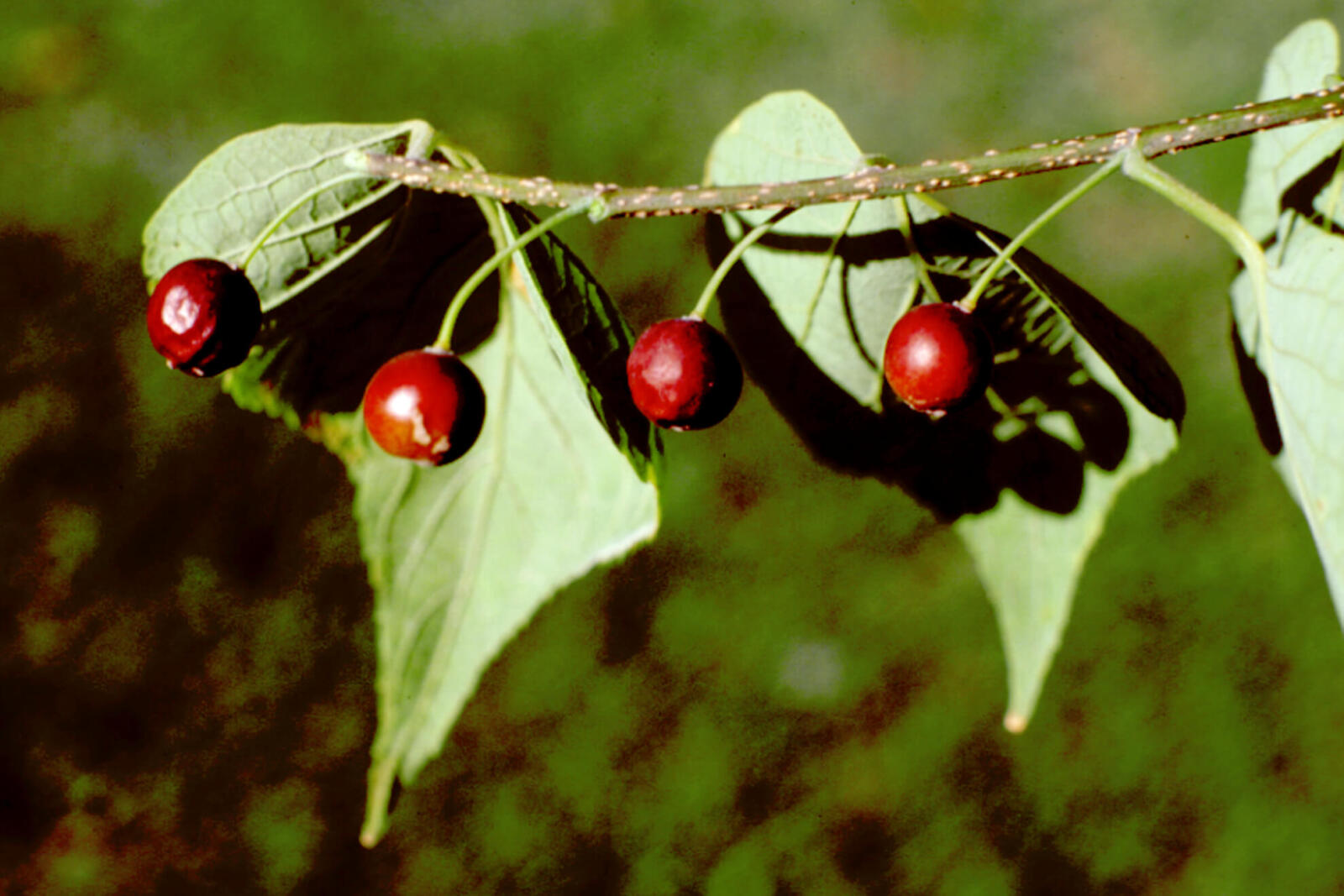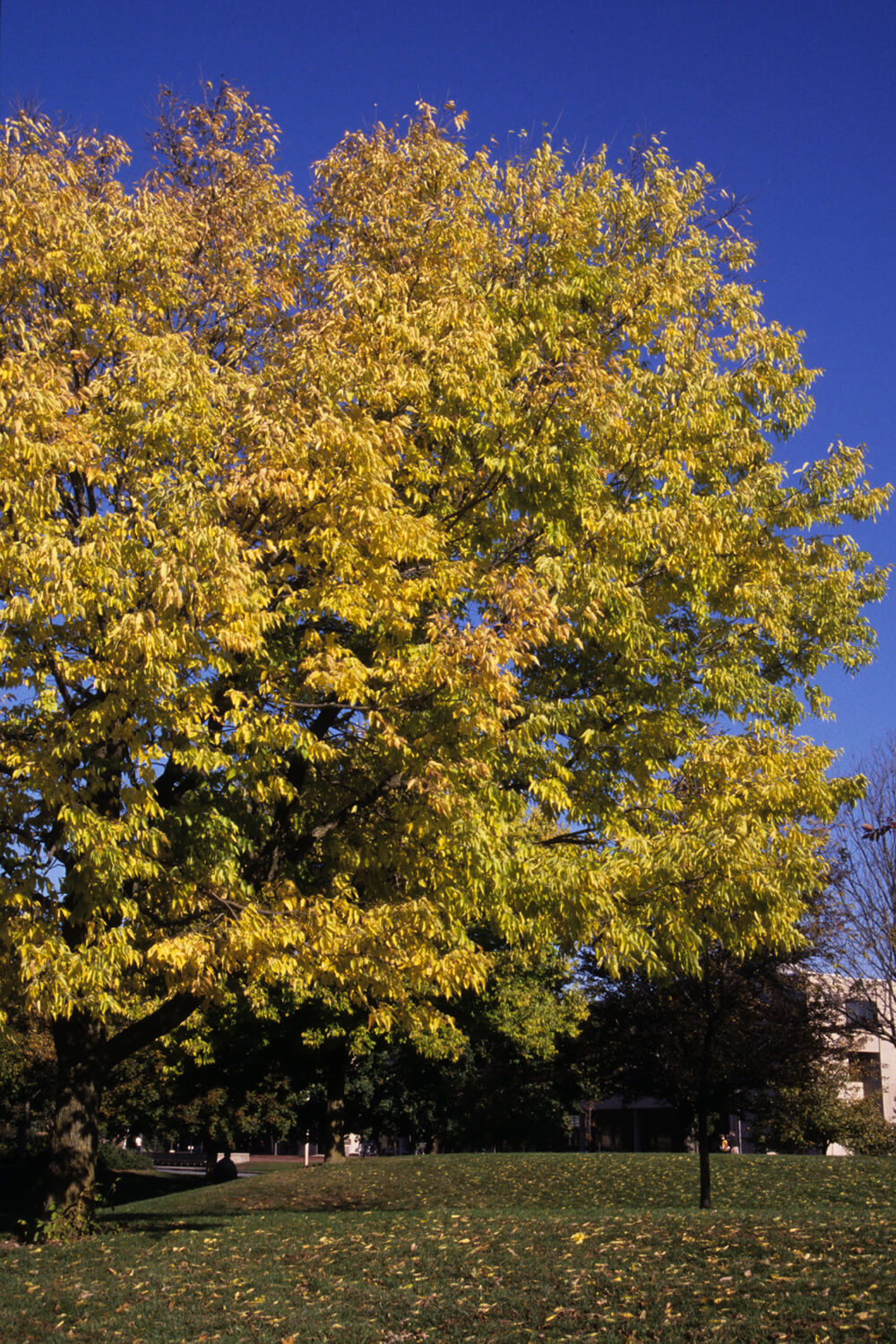March 15, 2012

The hackberry fruit is nutritious and delicious.
Common hackberry is not grand, but it’s a survivor
By Thelma Kessel
You may know the common hackberry (Celtis occidentalis) as the brave little tree that survives parking lot islands, its pale lime leaves covered in weird bumps. It perhaps is not the grandest tree in our expectations of canopy in the urban environment. But its survival only emphasizes the usefulness of Celtis occidentalis.
A. L.Jacobson writes in his book, North American Landscape Trees,“Lacking flamboyance and romantic associations, hackberries are like cinder blocks: eminently useful but stigmatized by default.” Yet, the hackberry has many features, making it one of the cinder blocks of the landscape.
Hackberries were frequently planted as alternatives to elm. The elm-like vase shape of the hackberry can be found through much of eastern and central U.S., southwestern Quebec and expanding regions of Southern Ontario. Mature trees can be 12 to 25 metres tall with a highly variable lifespan of up to 150 to 200 years. The bark of the common hackberry is perhaps the most interesting feature. It is rich with corky ridges that have distinctive stratified layers that look very geological.
Alternately-budded twigs end in a unique horizontal-oriented bud. The simple leaves have an asymmetrical base and a long tapering tip. They become a subdued green through the season, turning to yellow in the fall. Both male and female flowers are found on the same tree, though they are inconspicuous. After wind pollination, the small fleshy drupe that develops may persist on the tree until spring.
Many species of birds and animals will enjoy the nutritious hackberry banquet throughout the winter. The dry fruit has been described sometimes as messy on sidewalks. This may be noted in areas with little animal diversity, because even squirrels and chipmunks eagerly search for the fruit.
Pest issues in Celtis occidentalis are limited to cosmetic issues such as witches broom and nipple galls. There are cultivars that offer more resistance to these problems.
 The hackberry’s solid branching structure becomes more elm-like with age.
The hackberry’s solid branching structure becomes more elm-like with age.
The hackberry grows in a wide-range of soils, from moist bottomland to dry rocky sites. Hackberries growing naturally in Ontario are primarily found on dry limestone outcroppings, which may suggest some natural selection for drought tolerance.
Shade tolerance and tree shape are also variable. Sourced seed could provide some uniformity. Seed from drought tolerant stock is more suited to urban sites, than seed from moist-rich bottomland stock.
Consider common hackberry for several reasons. It exhibits tolerance of challenging sites and it is ecologically important to birds, butterflies and mammals and shows little disease. These are all important factors in repopulating our urban forests.
Funding was from the Farm Innovation Program, to the Landscape Ontario Growers’ Sector Group, which initiated the research project to develop a list of urban-tolerant trees that could be offered to the Ontario landscape industry. The project team, led by Thelma Kessel of Lacewing Horticulture, included Sean Fox, assistant manager, University of Guelph Arboretum, Jennifer Llewellyn, OMAFRA nursery crops specialist, and Dr. Glen Lumis, Professor Emeritus, University of Guelph.
The 29 trees on the list are considered suitable for Ontario urban settings, while encouraging species diversity. The research group feels the trees on this list have tolerance to urban situations, along with aesthetics and relative freedom from pests and diseases. The trees are similar to ash in size and form. Smaller specimens were included for sites where ash would be too large.
You may know the common hackberry (Celtis occidentalis) as the brave little tree that survives parking lot islands, its pale lime leaves covered in weird bumps. It perhaps is not the grandest tree in our expectations of canopy in the urban environment. But its survival only emphasizes the usefulness of Celtis occidentalis.
A. L.Jacobson writes in his book, North American Landscape Trees,“Lacking flamboyance and romantic associations, hackberries are like cinder blocks: eminently useful but stigmatized by default.” Yet, the hackberry has many features, making it one of the cinder blocks of the landscape.
Hackberries were frequently planted as alternatives to elm. The elm-like vase shape of the hackberry can be found through much of eastern and central U.S., southwestern Quebec and expanding regions of Southern Ontario. Mature trees can be 12 to 25 metres tall with a highly variable lifespan of up to 150 to 200 years. The bark of the common hackberry is perhaps the most interesting feature. It is rich with corky ridges that have distinctive stratified layers that look very geological.
Alternately-budded twigs end in a unique horizontal-oriented bud. The simple leaves have an asymmetrical base and a long tapering tip. They become a subdued green through the season, turning to yellow in the fall. Both male and female flowers are found on the same tree, though they are inconspicuous. After wind pollination, the small fleshy drupe that develops may persist on the tree until spring.
Many species of birds and animals will enjoy the nutritious hackberry banquet throughout the winter. The dry fruit has been described sometimes as messy on sidewalks. This may be noted in areas with little animal diversity, because even squirrels and chipmunks eagerly search for the fruit.
Pest issues in Celtis occidentalis are limited to cosmetic issues such as witches broom and nipple galls. There are cultivars that offer more resistance to these problems.
 The hackberry’s solid branching structure becomes more elm-like with age.
The hackberry’s solid branching structure becomes more elm-like with age.
The hackberry grows in a wide-range of soils, from moist bottomland to dry rocky sites. Hackberries growing naturally in Ontario are primarily found on dry limestone outcroppings, which may suggest some natural selection for drought tolerance.
Shade tolerance and tree shape are also variable. Sourced seed could provide some uniformity. Seed from drought tolerant stock is more suited to urban sites, than seed from moist-rich bottomland stock.
Consider common hackberry for several reasons. It exhibits tolerance of challenging sites and it is ecologically important to birds, butterflies and mammals and shows little disease. These are all important factors in repopulating our urban forests.
Urban tolerant trees
This is the third in a series of articles highlighting 29 trees selected by the Landscape Ontario Growers’ Sector working group, as recommended alternatives to ash and Norway maple. For the complete list and factsheets on each, go to landscapeontario.com/trees-for-urban-landscapes.Funding was from the Farm Innovation Program, to the Landscape Ontario Growers’ Sector Group, which initiated the research project to develop a list of urban-tolerant trees that could be offered to the Ontario landscape industry. The project team, led by Thelma Kessel of Lacewing Horticulture, included Sean Fox, assistant manager, University of Guelph Arboretum, Jennifer Llewellyn, OMAFRA nursery crops specialist, and Dr. Glen Lumis, Professor Emeritus, University of Guelph.
The 29 trees on the list are considered suitable for Ontario urban settings, while encouraging species diversity. The research group feels the trees on this list have tolerance to urban situations, along with aesthetics and relative freedom from pests and diseases. The trees are similar to ash in size and form. Smaller specimens were included for sites where ash would be too large.